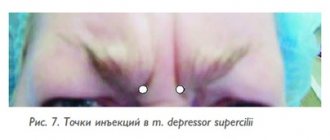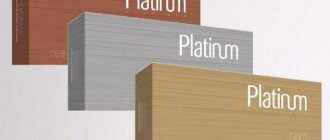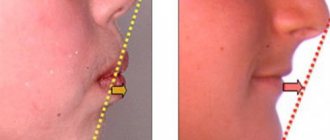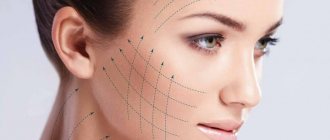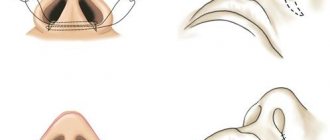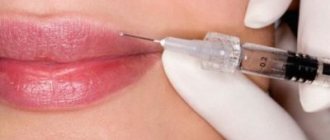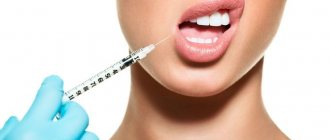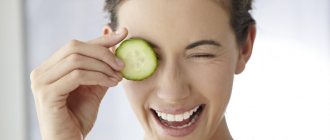Photos before and after Reviews Videos Rehabilitation Prices Analyzes Questions and Answers
A beautiful, young and attractive face is characterized by smooth, even and elastic skin that smoothly transitions from one area of the face to another, creating a harmonious contour.
With age, wrinkles, folds and grooves appear on the face, which become deeper over time . In addition, the soft tissues of the face descend and shift downwards, forming deeper folds above the places where the skin is fixed to the deep tissues of the face. These age-related changes become more noticeable over time. With age, even the soft tissues of the eyelids and areas around the eyes, under the influence of gravity, shift downwards and become thinner, which leads to the formation of paint bags, as well as the appearance of a more pronounced nasolacrimal groove. The appearance or deepening of the labiomental, nasolabial and nasolacrimal grooves is associated with drooping of the soft tissues of the face.
Correction of the nasolacrimal trough is the most complex procedure in facial plastic surgery . Aesthetic defects of the eyelids, ptosis of the soft tissues of the face and neck, low eyebrow position are the subject of surgical correction using well-known techniques in facial rejuvenation surgery. And circles under the eyes , which almost always accompany age-related changes in the face, have been underestimated and not taken into account for a long time, because they did not know how to deal with them. In other words, jowls, nasolabial folds, and drooping soft tissues of the neck have been solvable problems for many years, and the excellent results of eyelid surgery of the face and neck contrasted sharply with the unsatisfactory results of lifting the infraorbital region, which with age is limited to the nasolacrimal groove.
To rejuvenate her face, the patient underwent endoscopic brow lift and midface lift, temporal lift, lower eyelid plastic surgery, SMAS face and neck lift, and total facial rejuvenation.
More photos in the BEFORE AND AFTER photo gallery
Thus, a simple facelift with eyelid surgery gave an inharmonious result. Plastic surgeons realized the need to correct the midface and began to develop techniques that were supposed to solve the problem of rejuvenating the midface.
The nasolacrimal (nasozygomatic) groove runs from the nose towards the cheek . The most medial part of the groove, about 1 cm, is also present at a young age and can be considered a more or less permanent boundary between the lower eyelid and the cheek. What to call this groove, some call it the eyelid-buccal groove, others call it the lacrimal groove. However, the scientific world calls this groove nasozygomatic.
In almost every child or adolescent, a slight grooved depression is clearly visible along the inner edge of the orbit, caused by the reduced thickness of the soft tissues in this area and their fusion with the bone. When this furrow is more pronounced, which may be a congenital feature of the facial structure or a sign of aging, so-called “ under-eye circles ” appear around the eyes. Sometimes they are more pronounced due to hyperpigmentation of the skin of the lower eyelids. Brownish or bluish discoloration of the skin over the tear trough is associated with increased deposition of pigments in the skin of this area or with the small thickness of the skin itself, the transparency of which causes the visibility of the darker underlying orbicularis oculi muscle.
The drooping of the soft tissues of the face contributes to the deepening of the tear trough.
The main vessels and nerves of the infraorbital fossa and sulcus
To ensure the safety of filler injection when correcting the infraorbital groove and depression, it is necessary to first determine the routes of the main vessels and nerves , of which there are quite a lot in the infraorbital zone:
- infraorbital artery;
- infraorbital nerve;
- angular artery;
- facial vein;
- zygomaticofacial artery;
- zygomaticofacial nerve.
For successful correction of the infraorbital cavity and sulcus, it is important to choose the optimal type of filler and injection technique.
The infraorbital artery and nerve emerge from the infraorbital foramen approximately 0.6–1.0 cm below the orbital ridge along a line running vertically from the medial part of the pupil. The zygomaticofacial artery and nerve emerge from the foramen along the vertical edge of the outer edge of the lateral part of the orbital ridge, approximately 0.5–1.0 cm below the horizontal line drawn from the outer corner of the eye, and pass along the lower border of the infraorbital fat.
Correction of the tear trough in Makhachkala
In the fight against age-related changes in the face, one of the most pressing problems is the correction of the nasolacrimal groove. In aesthetic surgery and cosmetology, this procedure is considered the most difficult. Drooping of the eyelids and tips of the eyebrows, ptosis of the soft tissues of the chin and neck with the formation of a double chin, ptosis of the facial tissues with the formation of nasolabial folds and sagging cheeks - this is the whole range of aesthetic problems that we solve in our clinic in Makhachkala.
“Circles” under the eyes have been underestimated for a long time, since there were not enough effective methods to combat them. However, the successful results of the listed plastic surgeries on the face contrasted with the unsuccessful results of lifting the infraorbital zone. Therefore, midzone lift and blepharoplasty led to facial disharmony, and therefore various methods for correcting the nasolacrimal trough began to be developed and used.
The nasolacrimal groove is a fold below the bony orbital margin, about 1 cm long, directed from the inner corner of the eye to the outer. It delimits the infraorbital region. Many authors call the continuation of the groove to the buccal-zygomatic region nasozygomatic, and to the outer canthus - palpebromalar, or infraorbital.
The formation of the groove is due to the anatomical features of this facial zone, which consist in the presence of a dense septum (septum). Fixed by the upper edge on the bone structures, it connects the skin with the orbicularis muscles located around the eyes. Therefore, the tissues in the upper third of the face move much less than in the middle.
In young people, the nasolacrimal groove is almost invisible due to the high hydration, elasticity and firmness of the tissues. However, its severity depends on the individual inheritance of facial structural features.
With age (from 25-30 years), the septal ligaments, while remaining firmly fixed to the skin and bone, gradually weaken, stretch and lengthen. As a result, in areas with greater fixation of the skin, retractions form, and in areas with less fixation, sagging and protrusion of tissues. “Circles” appear under the eyes, having a bluish color due to the visibility of blood vessels through the thin skin, and the face takes on the sick, exhausted expression of a tired person.
Thus, the formation of the nasolacrimal groove is determined by three main factors:
- gravitational age-related tissue ptosis;
- changes in bone structure (rarefaction and smoothing of the surface);
- degeneration of subcutaneous fat, which is already thin in this area.
The timing of formation and severity of the nasolacrimal fold, in addition to heredity, is greatly influenced by:
- poor lifestyle and sleep disorders;
- dysfunctional disorders of the endocrine system;
- chronic diseases of the lungs, cardiovascular system, kidneys;
- excess body weight followed by rapid weight loss;
- smoking and alcohol abuse.
Correction methods in cosmetology
It is impossible to get rid of the nasolacrimal groove by using external cosmetics. They are more suitable for the prevention of aging, and only to a very small extent in the early stages of its formation. Currently, surgical and conservative correction methods have been developed.
- Injection lipofilling.
- Mesotherapy, bioreparation and contour plastic surgery.
- Hardware methods.
Injection methods
Mesotherapy and contouring using hyaluronic acid . If mesotherapy is advisable only for preventive purposes and at the very initial stages of fold formation, then correction of the nasolacrimal groove with hyaluronic acid fillers through contouring is the most effective non-surgical method. Today, thanks to modern and high-quality bioreparants and fillers, such as Delight, Ellanse, NUAcorp, Saniderm, Juvenell, Plinest, Revi, Curasen, Laennec, Mesoxanthin, Mesoai, Mesovarton, Mesoscalpt, PRP therapy... etc. aesthetic cosmetology is worthy competition for plastic surgery.
The method is relatively new and only in recent years has gained great popularity among both patients and doctors. This is explained by the almost absence of restrictions, the development of deep insertion techniques using a special cannula that prevents damage to blood vessels and nerves, as well as the emergence of the latest generation of fillers of not only high and medium, but also low density.
Different viscosities of the drugs allow them to be used selectively.
For example, due to thin skin, only low-density hyaluronic acid fillers are suitable directly for the nasolacrimal groove, and for its branch, the nasozygomatic groove, medium or high-density fillers are needed.
is effective for correcting this area .
According to its results, softlifting is similar to full-fledged plastic surgery on the face. This is largely due to a special technique for introducing fillers of different densities to great depths, and in ways that are different for each zone. The purpose and purpose of the procedure is to create or restore missing volumes.
Thanks to this technique, not only wrinkles and folds are smoothed out, but also the contours and oval of the face are restored. For example, it makes it possible to tighten the lower third of the face, eliminate sagging cheeks and correct the so-called “jowls”, give a beautiful shape to the cheekbones and outline them, give the skin a normal color, firmness and elasticity. The procedure also allows you to improve the condition of the middle facial zone and molar (infraorbital) area, raise the eyebrows and even the corners of the eyes. With the help of softlifting, it became possible to recreate the volume of tissue where it is necessary for normal perception of the face or to replenish lost volume.
So, if the method of contour plastic surgery, which involves the superficial introduction of fillers, can be called a 2D technology, then softlifting is already a volumetric (4D) modeling technology. The duration of the procedures is usually 15 minutes.
Specially designed, albeit simple, instruments are of great importance for carrying out the procedure. It is a syringe with a flexible, long, thin needle-cannula with a rounded tip and a lateral opening for the release of the injected drug. This design of the cannula ensures that in the process of moving up to the periosteum, it pushes the tissues apart without damaging them. As a result, there is no injury to tissues and blood vessels with the formation of significant hematomas and swelling, and there is no damage to nerve branches with the risk of subsequent impairment of skin sensitivity or contractility of a group of facial muscles.
Depending on the area being corrected, a specific filler is injected with a specific density precisely calculated for each zone. Several preparations with different densities can be used for the face of one person. Knowledge of topographic anatomy allows the doctor to create gel filling at different levels. In order to distribute the drug evenly after its administration, a light stretching massage method is used. This approach makes it possible to achieve natural tissue elasticity, restore lost facial contours and subsequently maintain them in the correct position.
Deep administration of drugs and their physical and chemical characteristics create conditions for a long-lasting effect of the procedure, and also eliminates the possibility that the gel will be felt under the skin, as happens when it is introduced superficially.
If necessary, the use of hyaluronic acid fillers is supplemented with:
- injection of botulinum toxin preparations, for example, in the area of the eyebrow folds, in the corners of the eyes (crow's feet), in the sub-eyebrow area.
- exposure to high-frequency electromagnetic pulses (RF-lifting), which stimulate an increase in the number of fibroblasts and the production of collagen and elastin;
- Hardware methods
- lifting through the deep impact of ultrasonic waves on the muscular aponeurotic system (SMAS).
- Microcurrents giving good drainage and improved microcirculation.
It is more expedient to use hardware methods of influence not as independent methods for correcting the nasolacrimal groove, but in combination with mesotherapy or contouring using hyaluronic acid fillers.
The effectiveness of any cosmetic procedure is largely determined by the timeliness of its implementation. Therefore, it is very important to provide regular skin care and prevent unwanted conditions in a timely manner.
“Javatkhanova Amina’s Beauty Clinic” in Makhachkala offers everyone who wishes to receive qualified advice from a cosmetologist who, after assessing the condition of your skin, will offer adequate programs for its care and restoration.
Also here, high-class specialists carry out the bioreinforcement procedure using certified preparations.
Make an appointment for a consultation with a cosmetologist by phone +79882919969
What fillers are used to correct the infraorbital socket and sulcus?
In general, fillers based on pure hyaluronic acid are safe and effective preparations for correcting the infraorbital socket and sulcus. An additional advantage of this type of filler is the ability to dissolve hyaluronic acid using the enzyme hyaluronidase .
This is especially important when working in the infraorbital region, where after contouring, unevenness often appears due to the exceptional thinness of the skin. To ensure an even texture after correction, it is necessary to use a very soft HA gel for subdermal injections .
| Pronounced nasolacrimal and nasozygomatic grooves in a middle-aged patient. PMG – palpebromalar groove, MCG - midbuccal groove, TTD – nasolacrimal trough; NG – nasobuccal groove. |
Rice. 2: grooves of the infraorbital region
The filler can be injected with a cannula or needle. The choice of tool depends on a number of conditions . For example:
- the needle is better suited for creating precise contours when the drug is injected subdermally over the orbicularis oculi muscle;
- The cannula is recommended to reduce the risk of vascular damage and serious bleeding when filler is injected into the deep fat layer under the orbicularis oculi muscle to compensate for volume.
Correction methods
It is impossible to get rid of the nasolacrimal groove by using external cosmetics. They are more suitable for the prevention of aging, and only to a very small extent in the early stages of its formation. Currently, surgical and conservative correction methods have been developed.
Surgical correction
It consists of using one of the following methods:
- Surgical lipofilling, which is applicable mainly for young and middle-aged patients who are psychologically inclined only to the isolated elimination of an aesthetic defect without radical changes in the contours of their face. The essence of the operation is to first remove adipose tissue from other parts of the body (abdomen, thigh) and fill the area of the nasolacrimal fold with it under local anesthesia. This procedure is performed when there is low skin tone in this area by making an incision in the conjunctiva (transconjunctival blepharoplasty) and lasts about 40 minutes. In the presence of very pronounced age-related changes, access is made through a skin incision.
- The meaning of the second method is to separate the adipose tissue of the lower eyelids and then lower it under the skin in the area of the nasolacrimal groove. This technique is used as an addition to lower eyelid blepharoplasty or midface lift if the patient has lower eyelid hernias, a pronounced nasozygomatic groove, and many wrinkles and folds in the said area.
Surgical correction of the upper and lower eyelids
Surgical correction methods are quite effective and long-term. At the same time, they carry the risk of uneven filling of the nasolacrimal fold with fatty lumps with their subsequent contouring, especially in people with thin skin. In addition, performing the operations themselves under anesthesia or even under local anesthesia has a number of limitations associated with concomitant diseases.
How to get rid of a nasolacrimal trough - non-surgical methods
These include:
- Injection lipofilling.
- Mesotherapy and contouring.
- Hardware methods.
Injection methods
Injection lipofilling is carried out using the adipose tissue of the recipient himself. It is obtained from the thigh, abdomen or other areas, centrifuged, washed and, using a syringe and cannula, injected under the skin in the area of the nasolacrimal groove.
Positive results last for 3 years, but often subsequently the adipose tissue can be contoured on the surface of the skin, creating an uneven relief. In addition, some of the fat cells do not take root and die, which also reduces the effectiveness of the procedure.
Read more about this method in the article “Lipofilling”.
Mesotherapy and contouring using hyaluronic acid. If mesotherapy is advisable only for preventive purposes and at the very initial stages of fold formation, then correction of the nasolacrimal groove with hyaluronic acid fillers through contouring is the most effective non-surgical method.
Application of filler
The method is relatively new and only in recent years has gained great popularity among both patients and doctors. This is explained by the almost absence of restrictions, the development of deep insertion techniques using a special cannula that prevents damage to blood vessels and nerves, as well as the emergence of the latest generation of fillers of not only high and medium, but also low density. In addition, the inclusion of lidocaine (a local anesthetic) makes the procedure painless and comfortable.
The different viscosities of the drugs allow them to be used selectively. For example, due to thin skin, only low-density hyaluronic acid fillers are suitable directly for the nasolacrimal groove, and for its branch, the nasozygomatic groove, medium or high-density fillers are needed. The only drawback of contour plastic surgery is the relatively short period of preservation of the effect - on average 6-8 months, after which the procedure can be repeated.
The softlifting technique is effective for correcting this area.
Softlifting
Hardware methods
- exposure to high-frequency electromagnetic pulses (RF-lifting, Thermage), which stimulate an increase in the number of fibroblasts and the production of collagen and elastin;
- lifting through the deep impact of ultrasonic waves generated by the Uitera System apparatus on the muscular aponeurotic system (SMAS).
It is more expedient to use hardware methods of influence not as independent methods for correcting the nasolacrimal groove, but in combination with mesotherapy or contouring using hyaluronic acid fillers.
Indications and contraindications for the procedure
The area of the nasolacrimal groove is covered with thin skin, as a result of which the strip can form at a young age.
Factors contributing to this:
- individual anatomical structure;
- changes associated with age: the structure of muscle tissue changes, they stretch due to a lack of collagen, lumps, indentations, dark circles, etc. appear.
Fillers are recommended for use in the following cases:
- depressions have formed under the eyes;
- there is a clearly defined vascular network;
- darkening of the skin under the eyes appeared.
It is allowed to perform manipulation on young clients who have reached the age of eighteen.
Read material on the topic: How to remove wrinkles on the face: the most effective methods
Strict contraindications for correction of the nasolacrimal trough using fillers are:
- blepharoplasty with a statute of limitations of less than six months and a year;
- tendency to form scars;
- acute kidney disease;
- exacerbation of various inflammations;
- skin pathologies that appear in the area of the proposed procedures;
- neurological contraindications, including epilepsy;
- hemophilia and poor blood clotting;
- infectious diseases.
Relative restrictions are high temperature, acute respiratory viral infections, acute respiratory infections, pregnancy and the breastfeeding stage. It is allowed to apply procedures after the disappearance of conditional contraindications.
How does the procedure work?
Depending on the age and reasons for the formation of the furrow, the doctor chooses the drug. Usually this is Radiesse - an American filler or Juvederm, Surgiderm - French drugs, Restylane, Perlane - Swedish drugs.
Most often, the doctor will suggest not just filling the area of retraction, but carrying out a complete correction of the cheekbone, that is, correcting the buccal groove - this is a continuation of the tear groove in the cheek area and the cheekbones themselves.
A story about injectable fillers from 03:00
Causes of nasolacrimal trough
According to anatomy, the nasolacrimal groove is the gap between the fatty packets: the medial buccal and infraorbital. This space is connected to the bone of the infraorbital region by a special wall of muscles called the “septa”. Age, as well as various negative reasons (insomnia, addictions, fast food) reduce the density of muscle tissue.
The septal septum undergoes changes, transforming nearby fibers. An arched fold appears under the lower eyelid, and the skin between the bridge of the nose and the inner edge of the eye becomes dark due to poor circulation of body fluids. Taken together, these changes make the face tired and exhausted.
Recommended articles on the topic:
- Ultrasonic facial peeling is a pleasant and beneficial procedure for your skin
- How to properly care for your skin
- How to remove wrinkles on the face: the most effective methods
The period of formation of the nasolacrimal groove is purely individual. For some, it will look like a barely visible stripe for many years, for others it can transform from slightly visible to obvious in a short period of time. Diseases of the endocrine system and sudden changes in weight have a strong impact on her. A rapidly appearing nasolacrimal groove requires a visit not only to a cosmetologist, but also to a therapist.
Result after correction of the zygomatic region
Usually the entire procedure takes no more than 20 minutes. But as a result, the effect exceeds all expectations. Because only VOLUMA can resist deformation and flattening under pressure of so many layers of overlying tissues, again, thanks to its structure, which fundamentally distinguishes it from Ultra 2,3,4. The lifting capacity of the drug is so great that the volume lasts up to 4 years.
Swelling never occurs because the drug is properly placed deep. It is possible to reach the medial compartment with Ultra 4, and perhaps this is offered somewhere in training. But I repeat, I never do this, because Ultra 4 is too light and will not withstand the pressure of the tissues, therefore, it will not give good volume.
It is very successful to place Exellens Visage (Aptos) threads after VOLUMA to complete the look. More on this in the section on threads.
If you are really looking for your doctor...
Gymnastics for cheekbones ↑
At a young age, you can slow down the process of withering of the dermis. Cosmetologists have developed a course of exercises for expressive cheekbones. The exercises are simple, take only 10 minutes, and can be done in the morning after washing your face. Here are the main ones:
1 exercise
Take a breath, puff out your cheeks. Close your lips and place your hands on your cheeks so that your fingers touch your ears. Press down on your cheeks, resisting the pressure of your hands. Hold for a few seconds and relax your face. Repeat 10 times.
Exercise 2
Stand in front of the mirror, your lips should take the shape of the letter “O”, press your tongue to the inner surface of your cheek and as tightly as possible. Next, move your tongue behind your cheek. Repeat 20 times on each side of the face.
Exercise 3
Imagine that you have a ball in your mouth and roll it in a circle over your upper lip, over your other cheek, and then across your lower lip.
Exercise 4
Open your mouth, roll your lips inward over your teeth, tense your cheek muscles. Place your hands on the sides of your face and move them upward, imagining your face lifting up. Repeat several times.
Exercise 5
Place your thumb at the very bottom of your cheek and pull it from the inside. Using muscle tension, press it back to your teeth.
CONCLUSIONS
Injections of the complex drug IAL-System DUO are recommended for use as a volumizing agent in the area of adipose tissue in the infraorbital region (SOOF). At the same time, the drug has a long-term stimulating effect on the cellular community and extracellular matrix, both independently and in combination with IAL-System ACP.
In addition, IAL-System DUO can be used in cases of visualization of the palpebromalar, lacrimal and nasobuccal grooves, with a decrease in skin elasticity and hydration in this area.
Due to the plasticity of the drug, the procedures are not accompanied by fluid retention and swelling of the lower eyelid. After performing the procedure, the patient subjectively feels his eyes more widely open, with a pronounced lifting of the skin of the eyelids (Fig. 5).
Rice. 5. Patient A.: before (A), immediately after (B) and 16 days after the procedure (C)
phitogen.ru LITERATURE:
1. Anatomy and volumizing injections. E2e 2. Radlanski RJ, Wesker KH The Face. Pictorial Atlas of Clinical Anatomy. 3. Alessandrini A. Destrutturazioni ipovolumetriche del viso (ID). L'ambulatory medico. 2012, 35, pp. 17–19. 4. Alessandrini A. Face Anatomy. Italia Medica & Acta Medica, 2020.
Publication date: March 19 `20
Removing lumps in the Bisha area ↑
The changes are aimed at removing excess adipose tissue in the Bisha area. The method is indicated for reducing cheeks, with a rounded face shape and deep nasolabial folds. The technique is a plastic surgery in which an incision is made on the inner surface of the mouth. Therefore, postoperative scars are absolutely invisible.
During plastic surgery, the Bisha lump is pulled out through the incision as a single block and an absorbable suture is applied. Then the manipulation is repeated on the second area.
During the rehabilitation period of about 4 days, swelling and pain are observed. Final progress can be seen after two weeks.
Before and after removing lumps in the Bisha area

